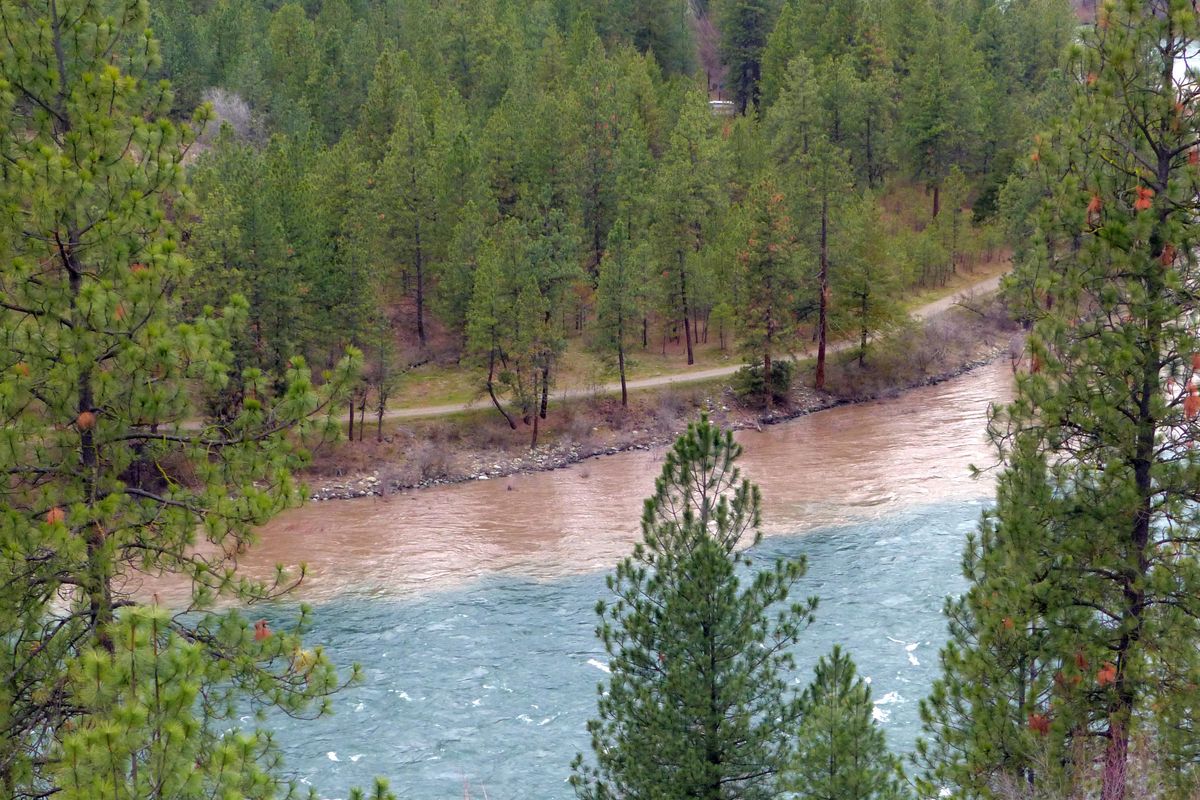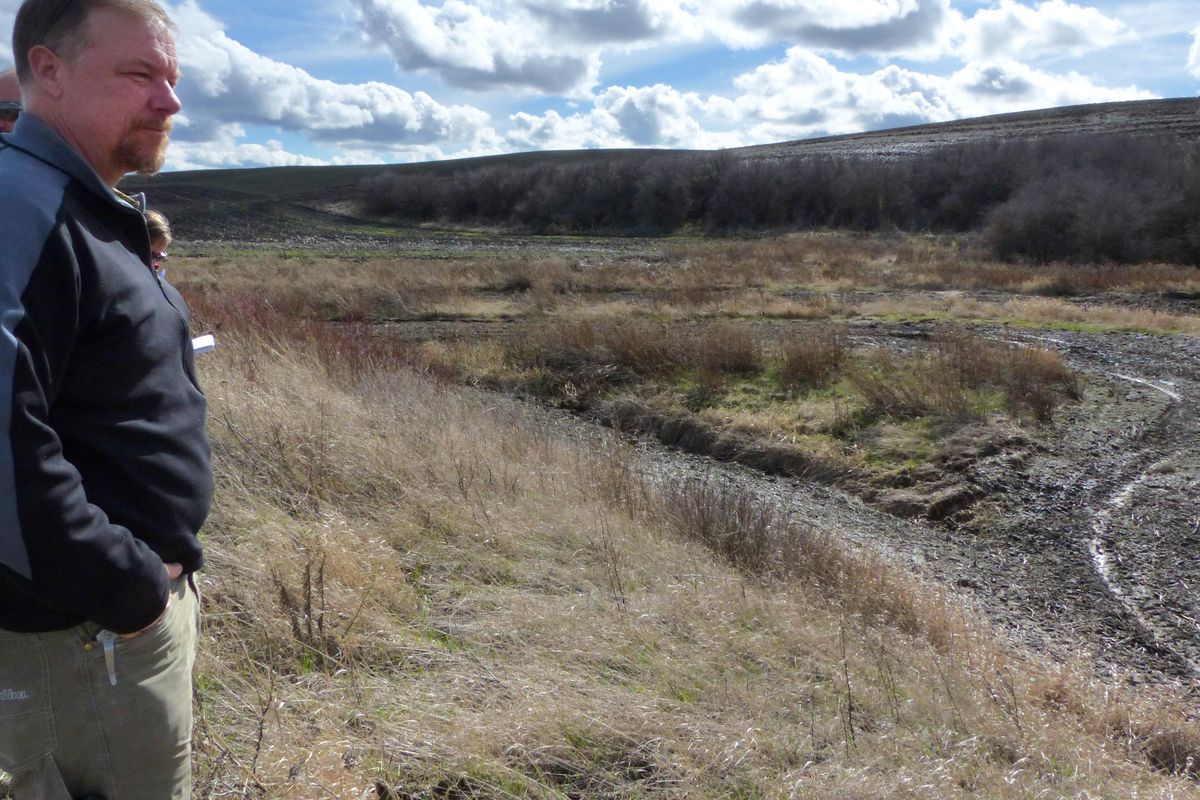Muddy waters: Hangman Creek cleanup essential to Spokane River health
2016 - The Spokane River, just downstream from Hangman Creek, shows the stripe of muddy water that the creek drops into the river during heavy spring runoff, shown March 11, 2016. It is a daunting task to stabilize miles of creek banks as it winds upstream through thousands of acres of farm land on the Palouse. (Jesse Tinsley / The Spokesman-Review)Buy a print of this photo
From his house, he can hike down an embankment to the Spokane River with his fly rod and catch and release native redband trout below the Monroe Street Bridge.
“It’s almost like you’re in Montana,” said White, who heads up the nonprofit Spokane Riverkeeper program, a citizen advocacy group for clean water. “It’s an amazing urban wilderness.”
But each spring, White noticed that half of the river ran brown: Where Hangman Creek flowed into the Spokane River, it left a long plume of dirt from Palouse farm fields.
“It belches mud when the trout are spawning,” he said.
Hangman Creek is one of the Spokane River’s largest tributaries, draining more than 400,000 acres of cropland, pasture and forest across four Washington and Idaho counties. Each spring, the creek runs frothy and caramel-colored, transporting thousands of tons of high-quality topsoil into the main stem of the Spokane.
Hangman Creek’s muddy water has been recognized as a pollution problem since at least the 1980s. Agriculture is a major contributor to the erosion, though roads, logging and residential development in the lower watershed also are factors.
The creek fails Washington’s water quality standards and contributes to algae blooms in the Spokane River reservoir behind Long Lake Dam.
Without addressing Hangman Creek’s problems, it will be difficult to achieve state water quality standards for the Spokane River – a multimillion-dollar effort spanning several decades. The cleanup effort has led to bans on phosphorus-rich dishwasher detergents, stricter pollution limits for municipal and industrial dischargers into the river, and tighter stormwater controls.
“Hangman Creek is definitely a player,” said Elaine Snouwaert, a Department of Ecology water quality specialist. “When it’s delivering sediment and nutrients to the Spokane River, then we have two water bodies affected by that pollution.”
For White, muddy water also equates to poor conditions for trout. Before dams blocked fish passage, some of the Spokane River’s redband trout migrated to the ocean as steelhead. The remnant redband population holds the genetic key to any future efforts to re-establish a steelhead run in the Spokane, he said.
‘Agriculture and clean water are both public goods’
But there aren’t easy solutions in the Hangman Creek watershed, where about 65 percent of the land is under cultivation.
The Palouse region, world-renowned for its wheat production, has light, fluffy dirt that erodes easily. Thousands of individual actions across the landscape muddy the creek, from erosion carving gullies in fields to cows trampling stream banks.
Most agricultural operations aren’t regulated under the federal Clean Water Act, the nation’s primary water pollution control law. In Washington, however, farming practices have come under scrutiny as municipalities spend hundreds of millions of dollars to meet conditions of stormwater permits, which require keeping polluted runoff from streets out of rivers and coastal bays.
Locally and statewide, efforts are underway to address runoff from fields and pastures. Approaches range from litigation to cooperation.
Last year, the Spokane Riverkeeper sued the U.S. Environmental Protection Agency and the Washington Department of Ecology, saying Hangman Creek’s 2009 cleanup plan hasn’t addressed runoff from fields and livestock operations that pollute the creek. The lawsuit is ongoing in U.S. District Court in Seattle.
“The agricultural industry is really lagging behind in putting together conservation practices to keep our water clean,” White said.
Department of Ecology officials have issued nine letters to Hangman Creek landowners about practices contributing to poor water quality since 2013, but haven’t taken follow-up action. Instead, the agency has channeled its efforts into a statewide agricultural task force to build better cooperation between farm groups and agency officials, with an end goal of cleaner water, said Kelly Susewind, special assistant to Ecology Director Maia Bellon.
“One of the criticisms you probably hear is that we don’t use that enforcement tool often enough,” Susewind said during a recent interview. “Our preference is a voluntary incentive approach.”
The agency works with landowners on solutions to problems, including financial assistance. Regulatory action occurs only if landowners aren’t responsive, Susewind said.
“Agriculture and clean water are both public goods that need to be supported,” said Evan Sheffels, a lobbyist for the Washington Farm Bureau, a participant in the task force. “We’ve got to have programs that help farmers and ranchers work through water quality issues.”
If agricultural lands convert to development, the potential impacts to water quality are even greater, Sheffels said.
State and local conservation groups recently secured $7.7 million in federal cost-share dollars to help farmers and timberland owners in the Spokane River watershed adopt practices that will reduce erosion.
Sign-ups for the program start this fall, with the goal of enrolling 300 landowners over five years. Though money will be spread over the entire Spokane watershed, the agricultural spending will focus on Hangman Creek.
The concentrated effort should yield real gains in water quality, said Snouwaert, the Ecology official.
‘Muddy water is not natural’
On a gusty spring day, clouds billowed above bare fields on the Palouse. White and his co-worker, Jule Scholtz, spent the morning driving almost the entire 57 miles of Hangman Creek, starting near The Creek at Qualchan Golf Course south of Spokane and ending on the Coeur d’Alene Reservation. They stopped frequently to take water samples.
The water in some of Hangman Creek’s tributaries was clean and clear, particularly where the tributaries flowed out of forested areas. But where streams passed through farm country, the water was often dirty.
Scholtz held up a bottle of water the color of iced tea. Sometimes, the samples are too murky to see through.
“Muddy water is not natural; it’s pollution. The reason this muddy water is happening is that there is no filter between the farm fields and the streams,” Scholtz said.
Redband trout still live in some of Hangman Creek’s cleaner tributaries. But in most of the creek itself, the muddy water would be similar to trying to breathe in the thick smoke from last summer’s wildfires, White said.
“Research shows that trout begin to cough in muddy water,” he said.
White has a hard time reconciling historic accounts of Hangman Creek with its current condition. Before Little Falls Dam blocked runs to the Spokane River, chinook salmon and steelhead migrated all the way to the creek’s Idaho headwaters. The Coeur d’Alene Tribe used to catch and dry fish near Tekoa, Washington, for winter food supplies.
To White, Hangman Creek represents both steep challenges and enormous potential.
“I’m such a fish hugger,” said the Cheney native, who started fishing with his grandfather as a kid during the 1970s. “When I pick up a native trout, I feel like I’m holding 20,000 years of the history of the land and the river.
“It’s something I think about all the time – how I can be part of the solution,” he said.
Creek’s troubles started long ago
Hangman Creek’s troubles began long before the current generation of landowners, said Walt Edelen, the Spokane County Conservation District’s water resources manager, who’s spent nearly two decades working on water quality issues in the creek.
To better understand the watershed, Edelen has canoed Hangman Creek and its major tributaries. He also researched old land surveys and interviewed elders from the Coeur d’Alene Tribe and multigenerational farm families.
Surveys from the late 1800s described rolling hills of bunchgrass prairie with scattered pine forests. Tangles of willows, cottonwoods and hawthorns grew alongside the creek and its tributaries.
But by 1920, much of the land had been cleared to grow wheat, peas, barley and lentils. Thousands of acres of forest were cut down. Streamside vegetation was removed, wetlands were drained and miles of stream channels were straightened.
Federal programs to increase agricultural production paid for some of the work.
The late Lawrence Aripa, a Coeur d’Alene tribal historian, worked for the Civilian Conservation Corps during the 1930s, digging ditches to drain wetlands and straightening portions of the creek. He was part of a crew of young Native American men.
“We knew it wouldn’t work, but we needed the jobs,” Aripa told Edelen during a 1998 interview.
In the years leading up to World War II, another 20,000 acres in the creek’s headwaters were converted to farmland. Marginal lands that shouldn’t have been cleared were put into production, a former Soil Conservation Service director later told Edelen. However, much of the work was accepted practice for the time.
“They believed what they were doing was a good thing. It was a benefit to the war effort,” Edelen said.
Hangman Creek has always been what hydrologists call a “flashy” stream, responding quickly to rainstorms. The land-use changes exacerbated the creek’s tendency to rise and fall rapidly, creating flows that shear off banks and send pulses of erosion downstream, Edelen said.
Hangman Creek can roar at 21,000 cubic feet of water per second during the spring runoff, and trickle at 10 cubic feet per second during the summer.
Even with the landscape changes, Edelen said, the federal cost-share programs could greatly improve Hangman Creek’s water quality. Between 100,000 and 150,000 acres in the watershed could qualify for erosion-control practices. The money will pay farmers to adopt conservation tillage practices, which reduce runoff by leaving stubble in fields and disturbing the soil less frequently. Farmers could also receive money for planting streamside buffers, which take high-yield areas out of production.
Streamside vegetation is one of the best ways to filter sediment and keep pollution out of rivers and creeks, said Snouwaert, the Ecology official.
“Agriculture is an important part of the state economy and preserving rural character,” said Andrea Rodgers, an attorney for Western Environmental Law Center. “It’s not impossible for us to do agriculture in a way that protects water quality. Those should not be conflicting goals.”
Restoration shows creek’s resilience
“I think there’s a sense with some people that Hangman Creek can’t be fixed, that it’s too far gone,” said Scholtz, the Spokane Riverkeeper’s water quality technician.
But a project underway on the Coeur d’Alene Reservation shows how resilient the creek is, he said.
The tribe has spent four years restoring a stretch of Upper Hangman Creek that used to be hayfields and pasture. The creek’s channel was straightened through the area in the 1930s when a logging railroad was built alongside it.
The railroad disappeared long ago, but the linear channel remained. Instead of meandering through the pasture and spilling over into the flood plain, the water shot through the channel at velocities that ate away the banks and created severe erosion problems.
Even beavers couldn’t live there. The force of the water blasted their dams away.
“It was a big dead zone,” said Bruce Kinkead, a fisheries biologist for the tribe.
With federal habitat restoration money, the tribe purchased 660 acres and returned the creek to its original, meandering path. It’s a lush area now, with a healthy stream and connected wetlands used by beavers, ducks, turtles and frogs.
The creek is cleaner, too. Sediment settles out of the water instead of being carried downstream, said Tom Biladeau, the tribe’s fisheries habitat biologist. Over time, the tribe plans to restore 2 1/2 miles of Hangman Creek, creating a corridor that connects isolated redband trout populations.
The tribe hasn’t given up on Hangman Creek as a fishing stream. The goal of the restoration effort is to restore a redband trout population that’s healthy enough to allow fishing.
Longer-term goals are even more ambitious, Biladeau said. “We want to prepare the landscape for the eventual return of steelhead and salmon, if possible.”










